FRENCH LETTER
Farewell to a fig tree
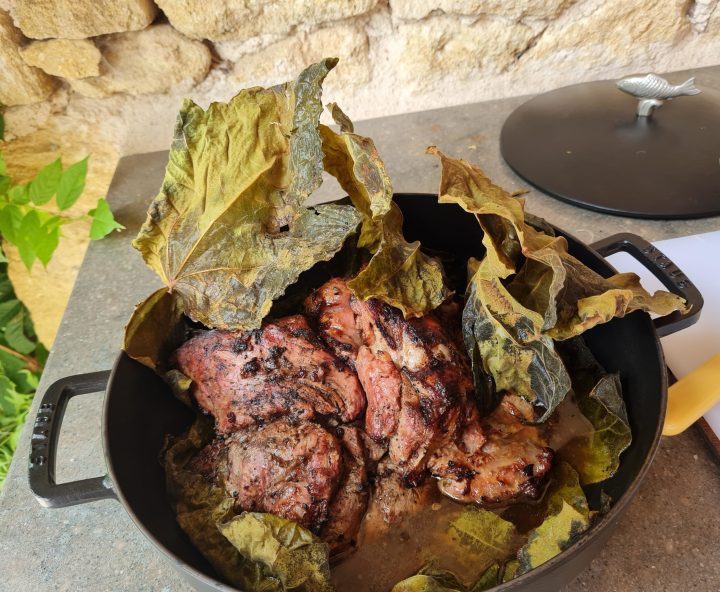
It is always hard to leave a house you love. If you planted your own fig tree and you have to leave in fig season, it can almost break your heart. Until you find that figs have a way of following you.
In the last frantic weeks of packing all our belongings before moving out of our home, I watched our little fig tree with ever increasing attention. The deep purple figs were slowly ripening in the late summer sun, and it felt like a matter of life and death to get one final chance to eat at least a few of them before we handed the keys of the house to the new owners.
I was relieved to hear they also loved figs and wouldn’t let them rot on the branches. It was a consolation that someone would enjoy these heavenly fruits from the misshapen tree I had planted against a wall close to the washing line. I chose this modest position because in my childhood memories fig trees were always found in the backyard, definitely not in the showy front garden. Next to the chicken coop in my grandmother’s agterplaas, next to the washing line in my mother’s last home.
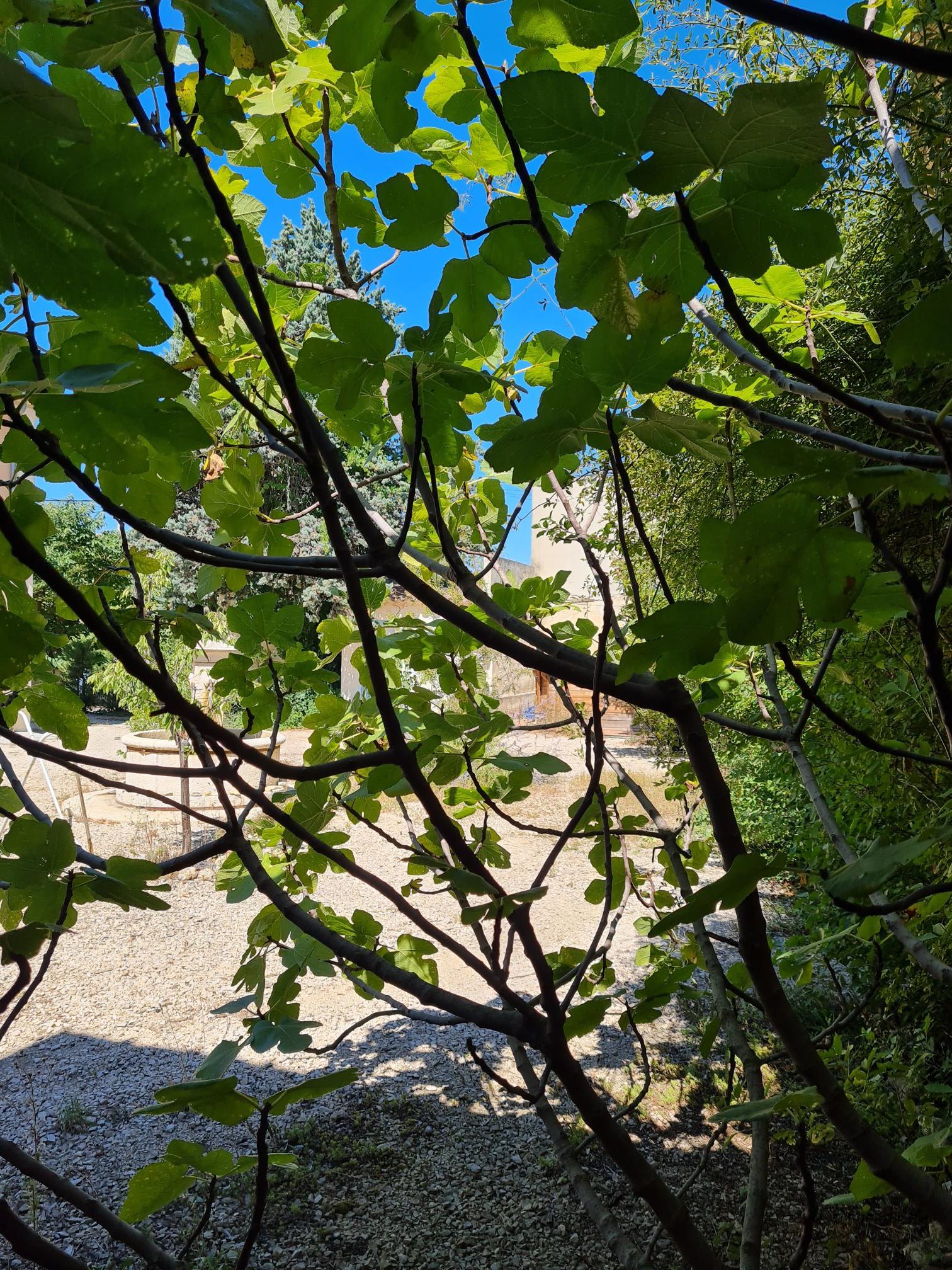
Our yard through the branches of the fig tree next to the washing line. (Photo: Marita van der Vyver)
Despite their humble surroundings, these trees bore the queen of all fruit, the stuff of legends, the ancient and anciently delicious Ficus carica. My mother made irresistible green-fig preserve from her unripe figs, and after her death my dad continued the tradition, using my mother’s mother’s recipe. (And claiming that his version tasted better than theirs.) I had tried making this green fig preserve in France long before I planted my own fig tree, and when it didn’t taste as good as my parents’ preserve, I assumed it was due to my lack of jam-making skills.
But when a French friend, who happens to be a chef with his own restaurant, tasted my dad’s green-fig preserve, he immediately asked for the recipe and tried making it with the figs growing abundantly around his house. Tried several times, in fact, without achieving the desired taste of my dad’s preserve. And finally told me that French figs must be different from those of my South African youth.
I gratefully accepted this explanation as an excuse never to cook green figs again. Much easier to wait until they ripen and eat them straight off the tree.
In my first cookbook, Summer Food in Provence, I included a gushing ode to Ficus carica, and since then I’ve been praising this sweet and sensual fruit in various magazine columns and even novels. So, to avoid repeating myself, let me rather share the great DH Lawrence’s ode to fig-eating with you. He begins quite coyly by stating:
The proper way to eat a fig, in society,
Is to split it in four, holding it by the stump,
And open it, so that it is a glittering, rosy, moist, honied, heavy-petalled four-petalled flower.
And just in case anyone still doubted the sensual and sexual undertones of eating a fig, the poet dispels all doubt a few lines further:
But the vulgar way
Is just to put your mouth to the crack, and take out the flesh in one bite.
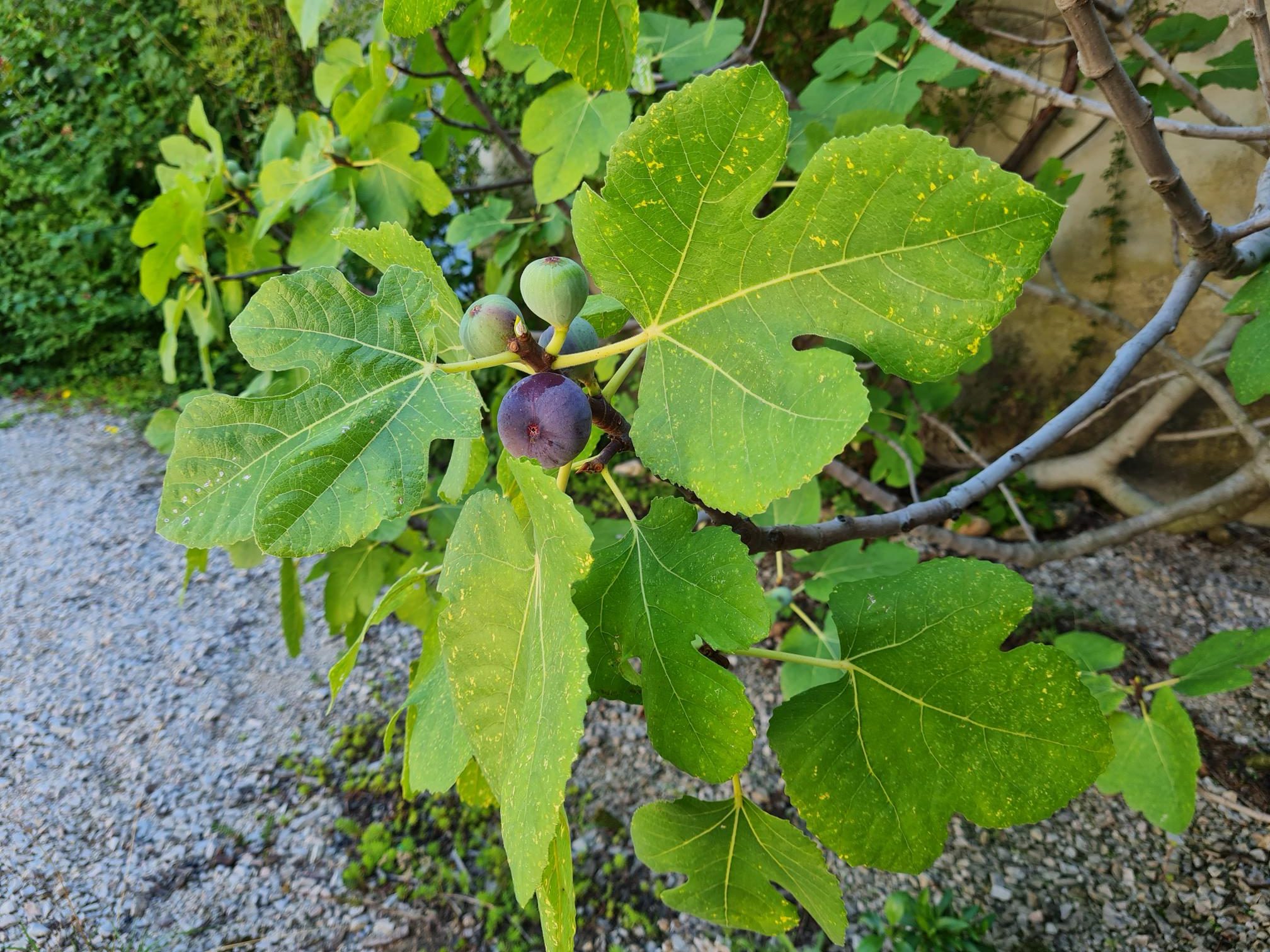
Slowly ripening into purple perfection. (Photo: Marita van der Vyver)
No wonder, then, that as we drove away from our home for the last time, I jumped out of the car, ran to the fig tree and picked three soft purple figs for the road. Padkos, as Ma would call it. Soul food, I would say, for my overflowing memory box.
What I didn’t realise, as I watched the fig tree fade away in the rear-view mirror, was that I would find the comfort of figs, sometimes in the strangest ways, while travelling through the south of France for many days. Provence has the ideal climate for figs, after all. And fortunately the fig season stretches well into September.
We spent our first two nights away from home (or what used to be home) at Domaine de Gerbaud near Lourmarin, a farm where old friends, also born in South Africa, have been producing high quality olive oil and wine for the past few years. I was pleasantly surprised when I walked into the kitchen and saw our hosts lining a casserole with beautiful bright green fig leaves. The deboned lamb shoulder served for lunch was quickly grilled over an open fire outside, then wrapped in the leaves and slowly cooked in the oven.
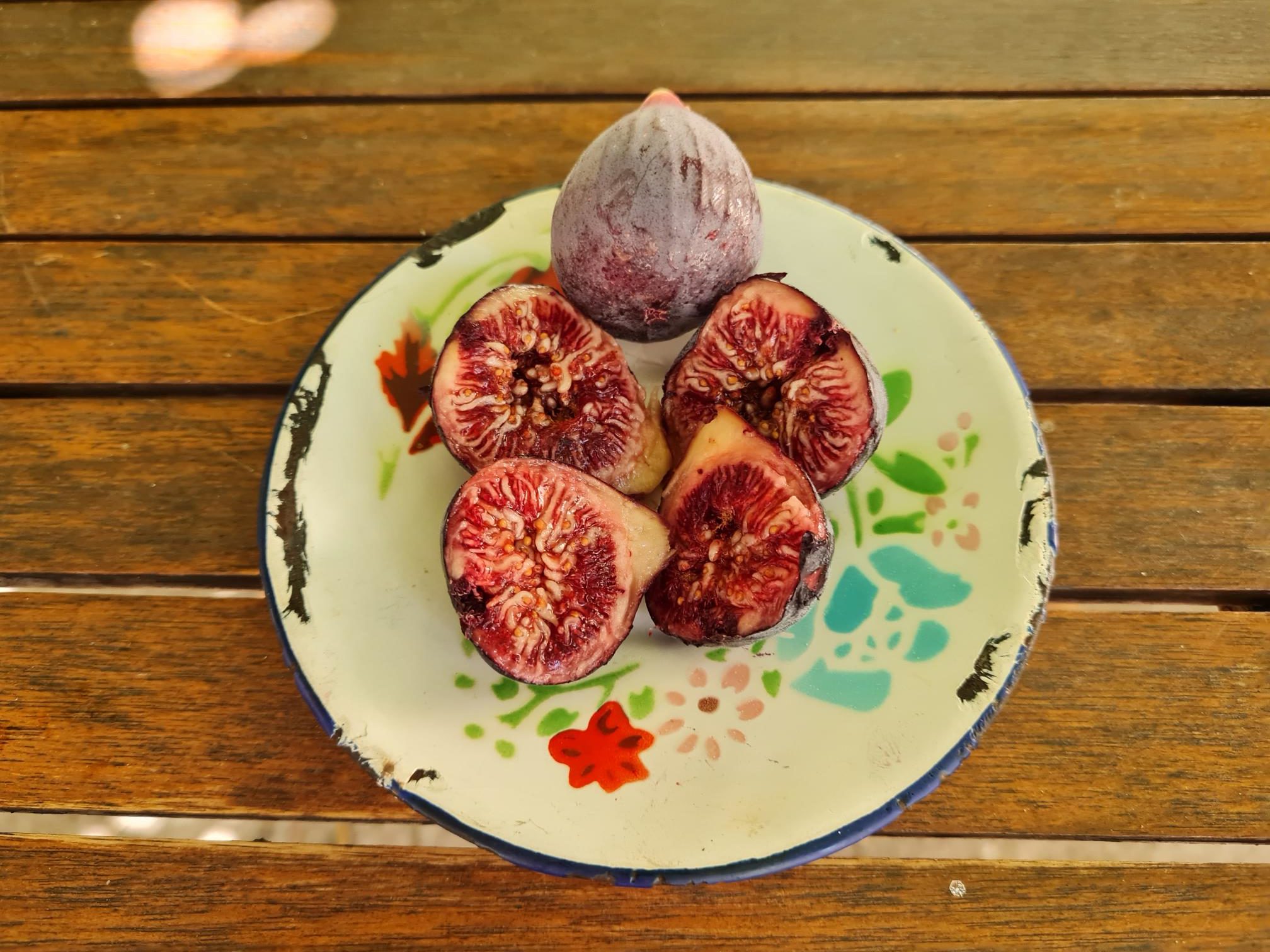
Straight from the tree. (Photo: Marita van der Vyver)
This was yet another culinary discovery for me. I love fresh fish wrapped in fig leaves and once I enjoyed a fabulous dish of lamb roasted with figs and lemon, but I’d never tasted a big chunk of meat cooked to a perfect pink juiciness while wrapped like a parcel inside fig leaves. And once again – like last time when I raved here about rice and meat wrapped in vine leaves – I was astonished at what Mediterranean cuisine can do with leaves we would usually throw away.
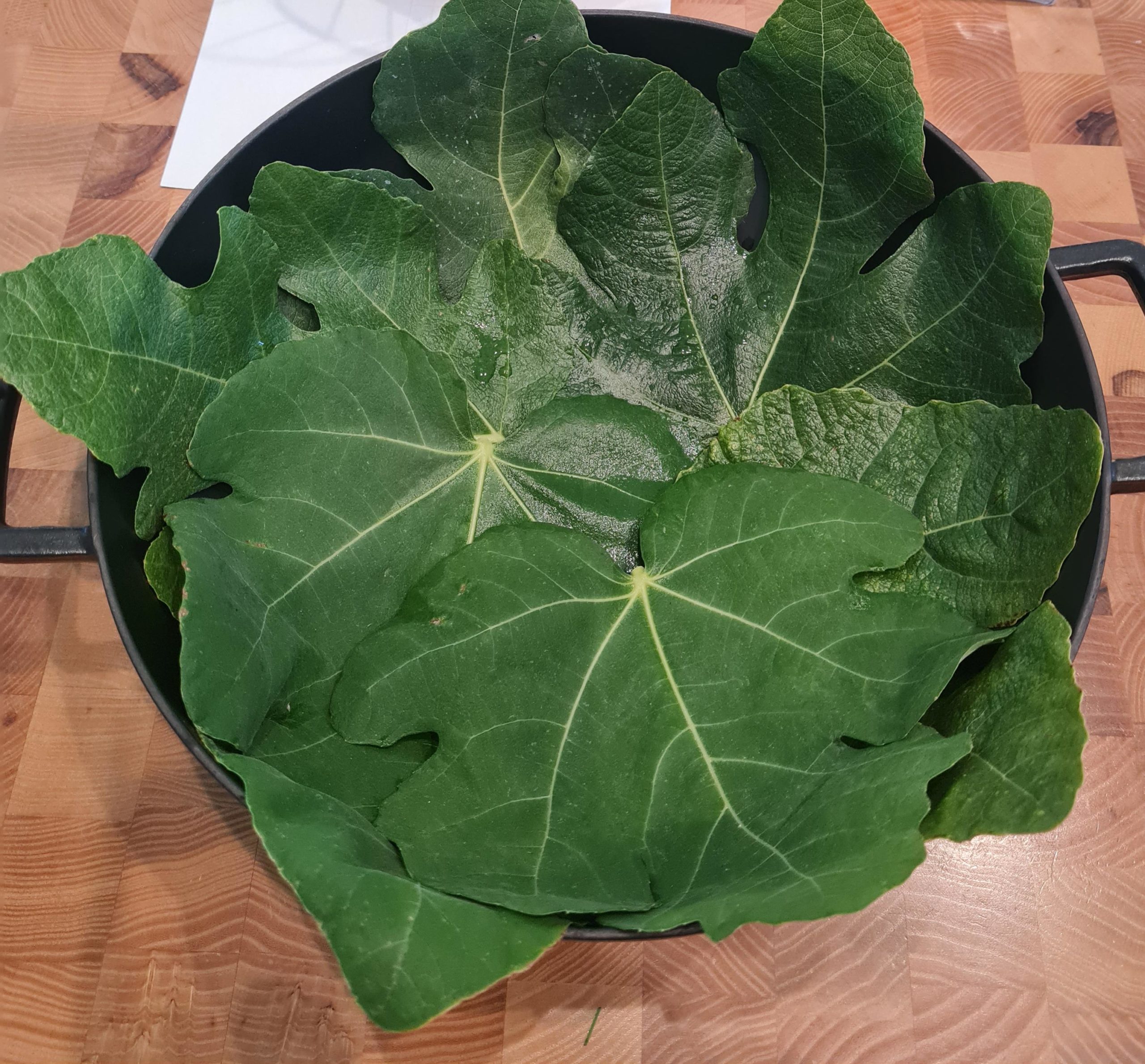
Fig leaves lining for shoulder of lamb. (Photo: Marita van der Vyver)
One of my favourite local cheeses also owes its fame to a wrapping of leaves – the little goat’s milk cheeses wrapped in chestnut leaves from the mountain village of Banon. So I suppose I can claim that I’ve learned to appreciate leaves. And when it comes to figs, although I still prefer the fruit to the leaves, I now know you can’t have the one without the other.
The next surprise, after leaving Lourmarin to meander northwards on back roads and avoiding the beaten track as much as possible, was the fig trees of the medieval town of Vézénobres. We landed here by pure chance, looking for an open bakery to buy fresh croissants. After driving through one deserted village after the other, we gave up the quest and decided to drink our coffee without croissants in Vézénobres.
What we found, instead of croissants, was a famous orchard with a thousand fig trees of about a hundred distinct varieties. These trees, from the national botanical conservatory on the island of Porquerolles, were planted here two decades ago, apparently because the town had long been known for its figs and especially for the production of dried figs. Recently Vézénobres even acquired a House of Figs to attract fig-crazy tourists and spread the glad tidings of figs as far as possible.
For me, a traveller mourning the loss of her own fig tree, it was serendipity. As if fate was trying to console me for losing one little tree by leading me to probably the largest collection of fig trees in France.
But the biggest surprise of all came a few days later, when the third fig I had picked from our tree rolled out from its hiding place as we unpacked the car, hundreds of kilometres north of what I still think of as our home. I grabbed the unexpected over-ripe purple gift and promptly ate it in “the vulgar way”, taking out the flesh in one greedy bite. And what a bite it was.
I swear it was the best fig I ever tasted. Perhaps it was really an exceptionally sweet and juicy fig. Perhaps it was simply because I knew it was the last one from that little tree I’d planted close to the washing line. DM/TGIFood
SUBSCRIBE: There’s much more from Tony Jackman and his food writing colleagues in his weekly TGIFood newsletter, delivered to your inbox every Friday. Subscribe here. Also visit the TGIFood platform, a repository of all of our food writing.
The author supports Ladles of Love, an NGO feeding the hungry and providing healthy food in Cape Town. You can support them here LadlesofLove.




 Become an Insider
Become an Insider
In Calvinia, Northers Cape where I grew up my mother had one fig tree in the small backyard that produced the most beautiful and sweet brown figs in April. That part of the country is ideal for growing fig trees – cold winters and very hot summers. Both my mother and I cooked fig jam and green fig preserve from fruit produced by that tree. All we used were figs, sugar and some lemon juice.I still have fig jam and fig preserve from ten years ago – beautiful and sweet tasting. I love fig trees. They produce in abundance with little care.